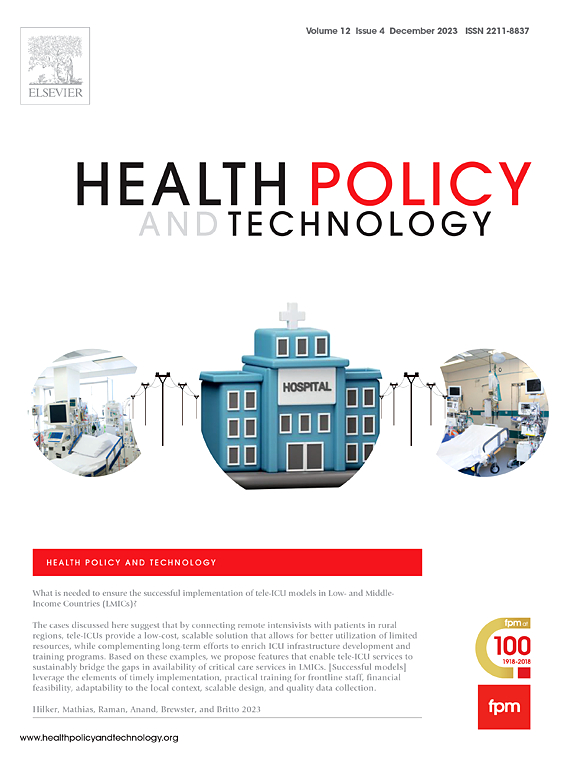利用全科医生模式实现孟加拉国全民健康覆盖的数字健康包容
IF 3.7
3区 医学
Q1 HEALTH POLICY & SERVICES
引用次数: 0
摘要
孟加拉国的卫生保健系统,特别是在农村地区,在提供完整的预防和初级卫生保健服务方面遇到了巨大的障碍,原因是缺乏足够的卫生保健设施,资源限制,以及功能不健全的转诊系统。为了缓解这些问题,在本研究中,我们为孟加拉国农村引入了数字全科医生(GP)模型、数字平台,并对从试点项目中收集的数据进行了统计分析。方法在试点项目期间,共有来自所有性别和年龄组的12,746人获得了定期保健服务,并提供了他们的社会人口和保健相关数据。我们通过描述性和推断性统计来分析医疗保健相关数据。结果利用数字全科医生模式,农村居民可以在家中进行常规健康筛查,及早发现健康风险,接受咨询和健康教育,并根据需要转诊到全科医生和上级卫生机构。我们发现高血压更为普遍(占服务人群的4.84%),而癌症是所有非传染性疾病中发病率最低的(占服务人群的0.05%)。在50-59岁年龄段,中风、高血压、糖尿病患者的比例随着年龄的增长而增加,随后随着年龄的增长而下降。女性严重营养不良的比例为3.96%,高于男性(2.34%)。结论农村人群中高血压、糖尿病等非传染性疾病较为普遍。应采取必要步骤,提高农村人口对预防和初级保健的认识。由于缺乏适当的卫生保健设施,资源有限,转诊系统功能不全,孟加拉国卫生保健系统无法在农村地区提供全面的预防和初级卫生保健服务。结果,患者患上了晚期疾病,包括非传染性疾病(NCDs),必须在昂贵的专科医院寻求治疗。为了解决这一问题,我们为孟加拉国农村引入了数字全科医生模型,然后展示了使用该概念的数字平台,最后总结了试点数字全科医生模型的重要发现。利用这种数字全科医生模式,农村居民可以在家中接受常规健康检查,及早发现健康风险,接受咨询和健康教育,并根据需要转诊到全科医生和上级卫生机构。通过数据分析,我们发现试点地区高血压、糖尿病等非传染性疾病负担较高。应采取必要步骤,提高农村人口对预防和初级保健的认识。本文章由计算机程序翻译,如有差异,请以英文原文为准。
Digital health inclusion towards achieving universal health coverage for Bangladesh utilizing general practitioner model
Objective
Bangladesh's health care system, particularly in rural areas, experiences enormous obstacles in providing complete preventive and primary healthcare services due to the lack of adequate healthcare facilities, resource constraints, and a non-functional referral system. To alleviate these problems, in this study, we introduce the digital general practitioner (GP) model for rural Bangladesh, digital platforms and present a statistical analysis of the data that was gathered from the pilot project.
Methods
A total of 12,746 people were provided regular health services during the pilot project, from all genders and age groups, and provided their socio-demographic and healthcare-related data. We analyzed healthcare-related data by carrying out both descriptive and inferential statistics.
Results
By utilizing this digital GP model, rural residents can receive routine health screenings at their homes, identify health risks early, receive consultation and health education, and be referred to GP and upper-level health facilities as needed. We found that hypertension was more prevalent (4.84% of the served population), and cancer was the least prevalent of all the NCDs in the studied population (0.05% of the served population). The population for stroke, hypertension, diabetes increased until the 50–59 age range as age increased, following which the population proportion declined as age increased. Additionally, 3.96% of young females were severely malnourished, comparably higher proportion than young males (2.34%).
Conclusion
NCDs such as hypertension, diabetes was prevalent among rural people. Necessary steps should be taken to raise preventive and primary healthcare awareness among rural people.
Public interest summary
The absence of proper healthcare facilities, resource constraints, and a non-functional referral system hamper Bangladesh's health care system's ability to provide comprehensive preventive and primary healthcare services in rural area. As a result, patients develop advanced ailments, including non-communicable diseases (NCDs), and must seek treatment at an expensive specialty hospital. To resolve this issue, we introduce a digital GP model for rural Bangladesh, then show digital platforms that use the concept, and lastly summarize significant findings from the piloted digital GP model. By utilizing this digital GP model, rural residents can receive routine health screenings at their homes, identify health risks early, receive consultation and health education, and be referred to GP and upper-level health facilities as need. From our data analysis, we discovered high burden of NCDs such as hypertension and diabetes in the piloted area. Necessary steps should be taken to raise preventive and primary healthcare awareness among rural people.
求助全文
通过发布文献求助,成功后即可免费获取论文全文。
去求助
来源期刊

Health Policy and Technology
Medicine-Health Policy
CiteScore
9.20
自引率
3.30%
发文量
78
审稿时长
88 days
期刊介绍:
Health Policy and Technology (HPT), is the official journal of the Fellowship of Postgraduate Medicine (FPM), a cross-disciplinary journal, which focuses on past, present and future health policy and the role of technology in clinical and non-clinical national and international health environments.
HPT provides a further excellent way for the FPM to continue to make important national and international contributions to development of policy and practice within medicine and related disciplines. The aim of HPT is to publish relevant, timely and accessible articles and commentaries to support policy-makers, health professionals, health technology providers, patient groups and academia interested in health policy and technology.
Topics covered by HPT will include:
- Health technology, including drug discovery, diagnostics, medicines, devices, therapeutic delivery and eHealth systems
- Cross-national comparisons on health policy using evidence-based approaches
- National studies on health policy to determine the outcomes of technology-driven initiatives
- Cross-border eHealth including health tourism
- The digital divide in mobility, access and affordability of healthcare
- Health technology assessment (HTA) methods and tools for evaluating the effectiveness of clinical and non-clinical health technologies
- Health and eHealth indicators and benchmarks (measure/metrics) for understanding the adoption and diffusion of health technologies
- Health and eHealth models and frameworks to support policy-makers and other stakeholders in decision-making
- Stakeholder engagement with health technologies (clinical and patient/citizen buy-in)
- Regulation and health economics
 求助内容:
求助内容: 应助结果提醒方式:
应助结果提醒方式:


